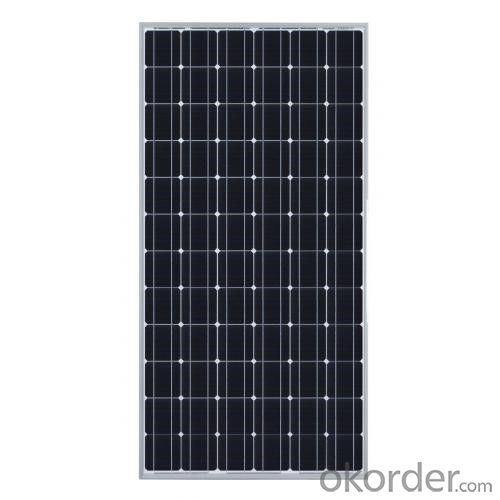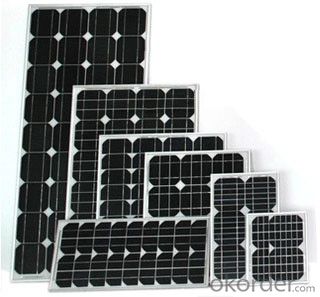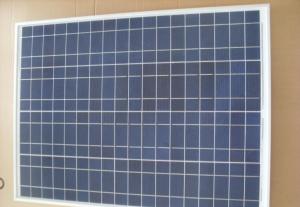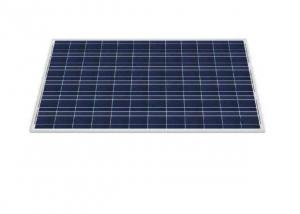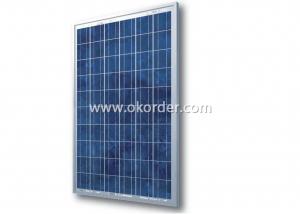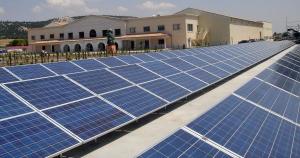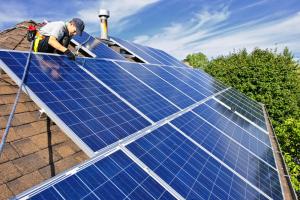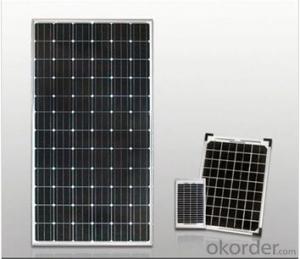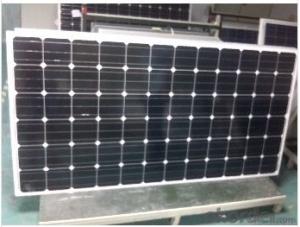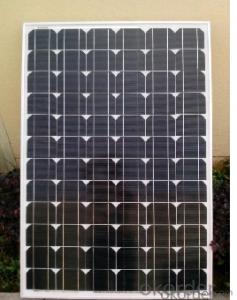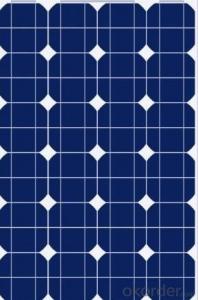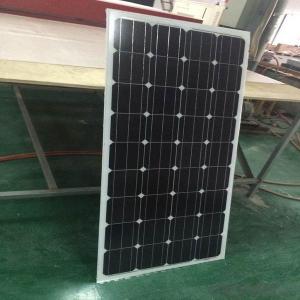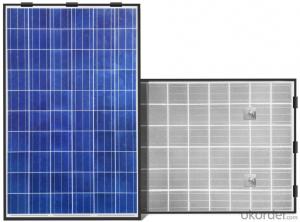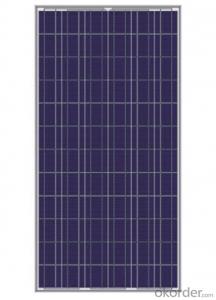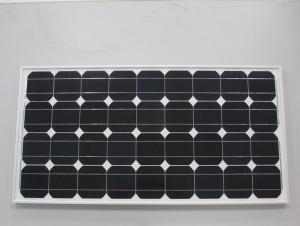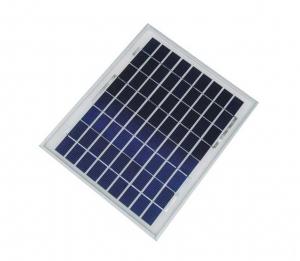145w High Efficiency Poly Solar Panels Made in China for Solar Panels in Florida
- Loading Port:
- Shanghai
- Payment Terms:
- TT OR LC
- Min Order Qty:
- 1000 watt
- Supply Capability:
- 1000000 watt/month
OKorder Service Pledge
OKorder Financial Service
You Might Also Like
Specification
Product Description
Solar module/panel with high efficiency solar cells
Strong, lightweight aluminum frame design with reinforced sealing and load hold to prevent freezing and warping, and stand against high wind.
Under Standard Test Conditions(STC): Irradiance of 1000W/m2, Am1.5 and 25º C cell temperature.
Mechanical Characteristics
Dimensions: 670mm(L) x 1460mm(W) x 35mm(H)
Weight: 14.5kg
Solar Cells: Polycrystalline solar cells, 36 cells
Construction: Front: High-transmission 3.2mm tempered glass; Encapsulate: EVA; Back: TPT
Frame: Clear anodized aluminum alloy Color: Silver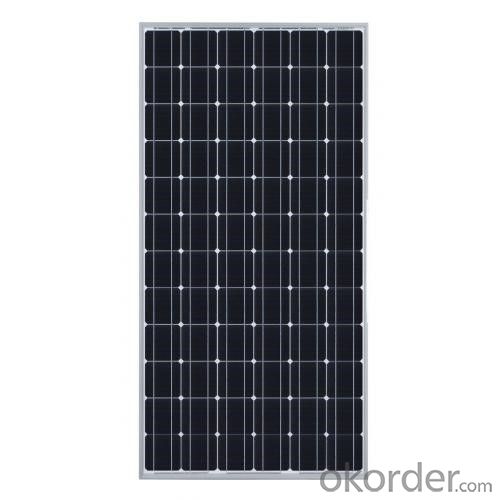
Product features:
1. The modules use high-quality imported polycrystalline or monocrystalline solar cells;
Enclosed by high-rigidity tempered glass, with excellent light transmittance and output performance;
2. Surface treated with reflection-reducing process, increasing the light absorption.
Back sealed with anti-aging EVA, resistant from moisture and corrosion.
3. The efficiency of our monocrystalline solar cell is over 17%, and polycrystalline panel is over 16%. We stipulate, the allowance of each panel's rated power has to be positive. Each panel is strictly tested before leaving the factory.
4. Our solar panel is designed with a lifetime of 25 years, and guaranteed that the power decline less than 10% within 10 years, and 20% within 20 years.
| Performance | |
| Rated Power[Pmax] | 145W |
| Power Tolerance | ± 5% |
| Nominal Voltage | 18.15V |
| Design Life | 25 years |
| Electrical Characteristics | |
| Maximum Power [Pmax] | 145W ± 5% |
| Maximum Power Voltage [Vmp] | 18.15V± 3% |
| Maximum Power Current [Imp] | 7.99A± 3% |
| Short-Circuit Current [Isc] | 8.69A± 3% |
| Open-Circuit Voltage [Voc] | 21.75V± 3% |
| Current Temperature Coefficient | 0.08%/º C |
| Voltage Temperature Coefficient | - 0.32%/º C |
| Power Temperature Coefficient | -0.38%/º C |
- Q: Can solar panels be installed on an RV or camper?
- Yes, solar panels can be installed on an RV or camper. In fact, many people choose to install solar panels on their recreational vehicles to harness renewable energy and reduce reliance on traditional power sources while on the road. Solar panels can provide a sustainable and efficient way to charge batteries, power appliances, and even run electrical systems in an RV or camper.
- Q: How do solar panels affect insurance premiums?
- Solar panels can have a positive impact on insurance premiums. Installing solar panels may increase the value of a property, which could lead to higher insurance coverage limits. However, the overall effect on premiums can vary depending on factors such as the location, type of solar panels, and the insurer's policies. Some insurers offer discounts or incentives for homeowners with solar panels, while others may charge higher premiums due to the increased replacement costs. It is advisable to consult with insurance providers to understand how solar panels specifically affect premiums in individual cases.
- Q: Can solar panels be integrated into buildings?
- Yes, solar panels can be integrated into buildings through various methods such as rooftop installations, solar facades, and building-integrated photovoltaics (BIPV). These approaches allow for a seamless integration of solar panels into the building's structure, providing renewable energy generation without compromising the overall aesthetics or functionality of the building.
- Q: Can solar panels be used in areas with high winds?
- Yes, solar panels can be used in areas with high winds. However, it is important to ensure that the solar panels are properly installed and securely mounted to withstand the high wind conditions. Reinforced mounts and sturdy frames are typically used to anchor the panels securely in place. Additionally, frequent inspections and maintenance might be required to ensure the panels remain intact and functional in such environments.
- Q: I have an electric bicycle that I travel to work by, pulling a modified child carrying trailer that holds two 2 volt deep cycle batteries in series to power the 24 volt bike motor. I'm thinking about adding a 50 watt solar panel (or larger depending on the room I can make available) to charge while I'm at work and to provide some extra juice while on my more distant travels.Can I get a solar panel to charge them while they're connected the way they are: in series? Does charging work that way?I've read that in order to charge the 24 volt battery setup (if the answer to the Q above is yes), the output from my solar panel would need to be a little more than 24 volts. Is this true? If so, how many volts?Since the bike is supposed to be powered at 24 volts and I have an x-volt (x gt; 24v) solar panel connected to it, will this cause any damage to the controller or other components while running them?Will it help supply power even while the motor is being run?Thanks.
- Yes, you have it right you need two 2V panels wired in series to give 24V to charge a 24 volt system. But along with the 24V you also want some amperage, otherwise it takes forever to charge. Most of the little chargers are called trickle charges because they only have an amp or two. If you had two 25 watt solar panels putting out 24V you have : watts = volts * amps 50 watt = 24V * x amps x = 2 amps If your battery is say 50 amp hours of storage, then if you are putting in 2 amps it will take you 25 hours of sunlight to power it back up from a dead battery. So the charge time depends on how many amps you are putting in there at 24V A car battery charger typically charges at 0 amps at 2V, so 2 * 0 = 20 watts of power going in there So if you go solar make sure to use a charge controller and a big enough panel to get close to 00 watts for any decent recharge time. The charge controller makes sure that the battery only gets voltage going one way and it least 24V. So if the sun went behind some clouds and the voltage dropped to 20V, the controller shuts off the current until the voltage equals 24V or more
- Q: Can solar panels be damaged by hail or extreme weather?
- Yes, solar panels can be damaged by hail or extreme weather. While solar panels are designed to withstand various weather conditions, including hail, severe storms with large hailstones or intense winds can potentially cause damage to the panels. However, most solar panels undergo rigorous testing to ensure they can withstand such conditions, and many manufacturers offer warranties to cover any damage caused by hail or extreme weather.
- Q: i need technical and non technical details to generate MW power by solar panels
- Sorry if I don't have all the specifics you asked for, but Sun Power makes the most efficient solar panels on the market, at close to 20% efficiency. They have made cells with up to 25% efficiency in the lab. That doesn't make it the cheapest but means the most watts per square foot. Thin film panels are cheaper to make but not as efficient. They are about half as efficient as conventional silicon panels. First Solar makes the cheapest per watt right now. So I guess that makes them the actuall cheapest manufacturer. They are able to make them cheap enough to beat out the conventional silicon panels on a per watt basis, despite being less efficient. A company called NanoSolar has the price down close to First Solar's price. These are manufacturers. But they do installations and build utility and commercial scale projects. NanoSolar is less far along in commercialization. They have products, but probably need to wait for the stock market to be more favorable for IPOs, so they can go public and raise the money to move up to scale. The other two are already public.
- Q: I got a really great deal on 2 houses because they were fixer-uppers. I'm living in one and the other I'm renting out. However, the previous owner did everything himself in 950 95, so needless to say, things are not to todays standards. Both houses need rewiring (there are no ceiling lights, few outlets, and mine has two old fuse boxes and the other has a breaker box but it pops the breaker a lot). The only reason they are still functional is because both houses use natural gas for water and heat, so otherwise, they electrical work is getting us by, but who knows for how long. I thought that maybe instead of redoing the electric, that I could just add solar panels to compensate for the small electric boxes. Also, since I would have to hire electricians to do all the work, which would be more cost effective (not including the decrease in utilities since I don't pay the utilities in the rental anyways)?
- No. solar panels would not solve your problems and are usually not cost effective. Solar panels will not help to compensate for undersized electrical service. You would still have to upgrade the existing service. Once that is done you should have no problems and all the electricity you need would come from your power company. Have an electrician come out and do an inspection and tell you what all needs upgrading. Solar panels would save you money on the monthly power bill but the cost to install them would be higher than your savings. If it made economic sense to have solar power then everybody would be doing it. That's why you see very few houses with solar panels on top.
- Q: What is a good sight that I could go to about installing solar panels and all of the considerations of it?
- Biggest problem is availability of sunshine in the UK. Do you get enough to warrant the fuss or financial layout? Another problem is the orientation of your roof. Facing directly south, with a slope (in degrees) equal to your longitude would be ideal. As far as electricity goes, you have to be tied into the grid to take care of the times you are not generating all the power you need. When you are generating more than you need, you sell it but get paid at the rate the utility normally pays, a lot less than you would pay to buy from them. Still, it's something.
- Q: Can solar panels be used in areas with high levels of bird or bat activity?
- Yes, solar panels can be used in areas with high levels of bird or bat activity. However, certain precautions should be taken to minimize potential risks. For instance, installing bird deterrents like netting or spikes can prevent birds from nesting or perching on the panels. Similarly, incorporating specialized designs or modifications can minimize the impact on bats. By implementing these measures, solar panels can coexist with bird and bat populations while still harnessing the sun's energy efficiently.
Send your message to us
145w High Efficiency Poly Solar Panels Made in China for Solar Panels in Florida
- Loading Port:
- Shanghai
- Payment Terms:
- TT OR LC
- Min Order Qty:
- 1000 watt
- Supply Capability:
- 1000000 watt/month
OKorder Service Pledge
OKorder Financial Service
Similar products
Hot products
Hot Searches
Related keywords



